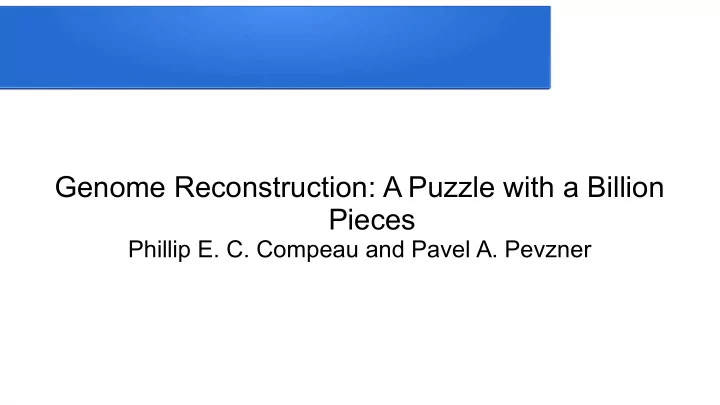

Genome Reconstruction: A Puzzle with a Billion Pieces Phillip E. C. Compeau and Pavel A. Pevzner
Outline I. Problem II.Two Historical Detours III.Example IV.The Mathematics of DNA Sequencing V.Complications
Problem Problem: Given DNA, how do we find the nucleotide sequence? Reduces to two problems: 1. Read generation (Biological) 2. Fragment Assembly (Algorithmic/Mathematical)
Introduction to DNA Sequencing Four Nucleotides: A, G, C, T No known way to read DNA one nucleotide at a time Current technology can only 'read' short segments of DNA − At most approximately 100 nucleotides in length − Short fragments of length k are called k-mers Biologists generate these k-mers starting at every nucleotide Then use mathematics to attempt to recover the sequence by solving a giant overlap puzzle
Brief Introduction to Read Generation First synthesize all possible 3-mers Attach these to a grid on which AAA AGA CAA CGA GAA GGA TAA TGA each l-mer is assigned a unique AAC AGC CAC CGC GAC GGC TAC TGC location Take the DNA fragment and AAG AGG CAG CGG GAG GGG TAG TGG fluorescently label it AAT AGT CAT CGT GAT GGT TAT TGT Apply this to the DNA array Read the complements of ACA ATA CCA CTA GCA GTA TCA TTA fluorescent grids ACC ATC CCC CTC GCC GTC TCC TTC ACG ATG CCG CTG GCG GTG TCG TTG ACT ATT CCT CTT GCT GTT TCT TTT
Welcome to Konigsberg a) Map of Konigsberg. b) The graph formed by compressing each land mass into a vertex and representing each bridge by an edge. Compeau, Phillip E C, Pavel A. Pevzner, and Glenn Tesler. "How to Apply De Bruijn Graphs to Genome Assembly." Nat Biotechnol Nature Biotechnology 29.11 (2011): 987-91. Web.
Konigsberg Bridge Problem Problem: Is there a walk that traverses each bridge exactly once? Euler solved this problem in the 18th century and spawned the branch of mathematics known as Graph Theory.
Hamilton's Game
From Euler and Hamilton to Genome Assembly Simplifying assumptions: 1.The genome we are reconstructing is cyclic. 2.Every read has the same length. 3.All possible substrings of length l occurring in our genome have been generated as reads 4.The reads have been generated without any errors.
Example Suppose we have the sequence: TAATGCCATGGGATGTT From this sequence, we yield the 3-mers: TAA, AAT, ATG, TGC, GCC, CCA, CAT, ATG,TGG, GGG,GGA,GAT, ATG,TGT,GTT We construct a graph from these 3-mers by: 1. Using the 3-mers as vertices. 2. Placing a directed edge from vertex 1, (v1), to vertex 2, (v2) if the prefix of v2 is the suffix of v1.
Example Prefix of AAT is AA while suffix of TAA is AA, etc.
Example In practice, k-mers are given in lexicographic order: AAT, ATG, ATG, ATG, CAT, CCA, GAT, GCC, GGA, GGG, GTT, TAA, TGC, TGG, TGT We again use the 3-mers as nodes Now we connect two nodes from one to another if the suffix is same as prefix For example, we connect AAT to all ATG nodes We yield a new graph that looks as follows. The goal is now to find a path in the graph that passes through every node exactly once. ( Hamiltonian Problem )
Example
Building the Path
Finally
Sequence then becomes: TAATGCCATGGGATGTT
Example Revisited We now approach sequence generation in a new way. Start again with the sequence: TAATGCCATGGGATGTT Generate 3-mers again: TAA, AAT, ATG, TGC, GCC, CCA, CAT, ATG,TGG, GGG,GGA,GAT, ATG,TGT,GTT The 3-mers now become the edges while the prefixes and suffixes become the nodes.
Example Revisited TA is the prefix of a 3-mer with AA as the suffix, so it is connected by an edge labeled by the 3-mer TAT, etc The next step is to paste together nodes that are the same.
Eulerian Problem The goal now is to find a path through the graph that passes through every edge exactly once. ( Eulerian Problem) When this path is found, concatenate the edges to retrieve the sequence.
When we read the edges back, we recover the sequence: TAATGCCATGGGATGTT
The Million Dollar Question Is the Hamiltonian Problem or the Eulerian Problem easier to solve?
Million Dollar Question Turns out that the Hamiltonian Problem is intractable − NP-complete − You can literally win a million dollars by solving it − Hamiltonian strategy still used to sequence the Human Genome and others before 2001 Eulerian Problem is very easy to solve − Proof of Euler's Theorem gives you a very nice algorithm to find the cycle
Euler's Theorem Theorem: A directed, connected, and finite graph G has an Eulerian cycle if and only if, for every vertex v in G , the indegree and the outdegree of v are equal.
Proof
Complications Eulerian Cycle found might not be unique − In our example there is also a cycle that generates the sequence: TAATGGGATGCCATGTT How does the problem change when the sequence is not cyclic, but rather, a linear DNA sequence? How do we adjust for errors in the read generation?
Thank You for Listening. Any Questions?
Recommend
More recommend